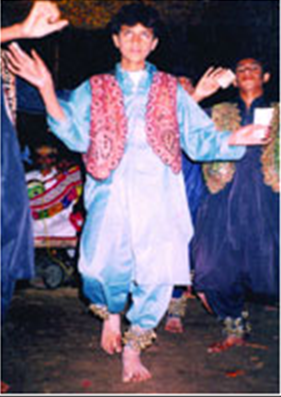Dancing boys and fairs of Sindh: Pakistan
This is a collection of articles archived for the excellence of their content. Readers will be able to edit existing articles and post new articles directly |
Dancing boys
By G H Khwaja
THE progress of Sindh has been hampered by two factors mainly. The ruthless control of feudal lords over socio-economic factors in the region and illiteracy. Superstition has also affected the intellectual growth of the people of Sindh to some extent. However, alongside all of this, certain things provide a strange kind of enjoyment to the general public. I am referring to the melas held annually at the shrines of different pirs and Sufis.
These melas are held on sites where in the past, the Sindhi topi-wearing villagers used to behead their dear ones in the name of karo-kari (honour killing). But now vulgar dances performed by eunuchs and teenage boys can be seen instead.
In lower Sindh, the harvesting time of major crops like sugar cane and rice heralds the beginning of the melas such as Melo Meher Shah Jo, Melo Jando Pir, Mo Ibrahim Shah Wari Waro and Melo Saman Sarkar. Teenage boys’ dances have always remained a major attraction for those who throng these melas. Wearing anklets and dancing to the rhythm of the dhol and chimta and swaying to the melody of harmonium, sarood and sarangi, these boys have the ability to grab the audiences’ attention. They are often attired in female dress to invite the attention of the people and never hesitate to openly kiss the villagers. This results in getting more money for the boys.
"I am in this profession because my elders were in it too. My father and older brother earned a lot of money through dancing, but when they grew up, they became hoteliers,” said Nabi Bux, 14, hailing from Tando Adam. He had travelled all the way from Tando Adam to Melo Ibrahim Shah Wari Waro located on an island in Thatta’s coastal belt.
He said, his elder brother Shakeel taught him how to attract and entertain the misery-stricken villagers through dancing -- the villagers who never hesitate showering money on entertainers.
Another dancer Waseh Ali said, “During the melas, police officials and some waderas get hold of us. The drunken policemen and influential waders often drag us to their autaqs and sexually abuse us.”
A little educated sarangi player, Ustad Khamiso Khan, while discussing the issue said that trying to educate these boys would be an exercise in futility. What could education do for them? One dancer earns on average Rs4,000 to Rs7,000 per night, not to mention some other valuables that they may get from their admirers.
Ustad Khamiso said, “The intricacies involved in the dance can be seen in the fact that despite being individually performed, there is a sense of collectiveness that goes along with the rhythm of the dhol and the chimta.”
Initially, some of the teenagers remain unaware of the various important dance moves like the moves that indicate the process of sowing, harvesting, the Bhangra moves, the snake charmer’s moves etc. But such moves don’t sell that much.
“Boys between the ages of seven and 12 are supposed to be the better ones in the business. Once they start getting older, they lose their charm, and business,” said Ustad Khamiso.
